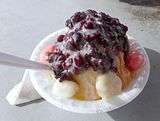Shave ice
|
Li-Hing & Lychee ice shaved from crack seed shop in Hilo, Hawai'i | |
| Type | Frozen dessert |
|---|---|
| Main ingredients | Ice, syrup, condensed milk (common variant) |
|
| |
Shave ice or Hawaiian shave ice is an ice-based dessert made by shaving a block of ice. While the product can resemble a snow cone, snow cones are made with crushed, rather than shaved, ice. Even though it is made with shaved ice, it is called "shave ice", not "shaved ice" in Hawai'i.[1] On the Big Island of Hawai'i, it is also referred to as 'ice shave', though both terms (ice shave and shave ice) are used by locals.
Shaving produces a very fine ice that appears snow-like. Flavored syrups are added to the ice, which are absorbed by the ice instead of surrounding it.[2][3] A properly made shave ice product rarely requires a straw, since the flavors are in the ice and not at the bottom of the cup. Although the traditional American flavors are common, shave ice in Hawai'i is often flavored with local ingredients such as guava, pineapple, coconut cream, passion fruit, li hing mui, lychee, kiwi fruit and mango. Hawaiian shave ice is traditionally served in a conical paper or plastic cup with multiple flavors and with a scoop of vanilla ice cream and/or azuki bean paste at the bottom of the cup. Sweetened condensed milk drizzled over the top is sometimes called a "snow cap." This style of shave ice is common on the north shore of O'ahu, as well as on Maui and the Big Island of Hawai'i (where it is called "Japanese style").
History
Shave ice traces its history to Japan, where it is known as kakigōri and dates back to the Heian Period.[4] "Shave ice enjoyed world-wide popularity after Japanese plantation workers immigrated to the Hawaiian islands and took their traditional dessert with them, creating shave ice from large blocks of ice and using Japanese swords which were family heirlooms."[5]
In other countries
"Snow ice"—cream, milk, water, sugar and fruit, frozen and then shaved and served in cones—is popular in Korea, Taiwan and Indonesia and making inroads into the United States.[6]
- Brazil - Raspadinha
- Bangladesh - Gola
- Colombia - Raspado
- Costa Rica - Copos and also called Granizado
- Cuba - Granizados
- Dominican Republic - Frío Frío and also in some parts of the country they are called Yun Yun
- El Salvador - Minuta
- France - Granite Hawaïen
- Guatemala - Granizada but in other parts of the country they are also called Raspado
- Guyana - Crush Ice or Snow Cone and are topped with condensed milk.
- Haïti - Fresco
- Italy - Granita, Grattachecca
- India - Chuski
- Taiwan - Baobing There is also a version known as snow flake ice which uses shaved frozen milk and other flavors.
- Japan - Kakigori
- Korea - Patbingsu
- Mexico - Raspado, Yuki (only in northern Mexico)
- Nicaragua - Raspado
- Peru - Raspadilla
- Philippines - Halo halo
- Puerto Rico - Piragua
- Malaysia, Singapore and Indonesia - Ais/Es kacang
- Pakistan, Baraf ka Gola
- Panama - Raspao, often topped with sweetened condensed milk
- Suriname - Schaafijs
- Thailand - Nam khaeng sai
- English and French Caribbean islands - Snowball
- Colombia - Raspado or Cholado
- United States - Shaved Ice
- Honduras - Minuta, often topped with sweetened condensed milk
- Mauritius - Glaçon Rapé
- Venezuela - Cepillados or Raspados, sweetened with fruit juice, artificial flavors and condensed milk
| Gallery | ||||||
|---|---|---|---|---|---|---|
|
See also
References
- ↑ Mike Gordon (2006). "Honolulu Advertiser". Shave ice. Retrieved 2013-09-04.
- ↑ Linda Stradley (2004). "Hawaiian Shave Ice". What's Cooking America. Retrieved 2010-06-12.
- ↑ "History of Snow Cones". ePopcorn.com. Retrieved 2010-06-12.
- ↑ Heather Stever. "Hawaii Shaved Ice". hawaiishavedice.com. Retrieved 2010-06-12.
- ↑ Cara Mazzei (August 4, 2010). "Sweet Sensations: The Haute 5 Ice Cream Shops in Honolulu". HAUTE LIVING MAGAZINE. Retrieved November 6, 2010.
- ↑ Thomas Rogers (2010-06-15). "Will "Snow Ice" be the next Pinkberry?". Salon. Retrieved 2010-06-16.


